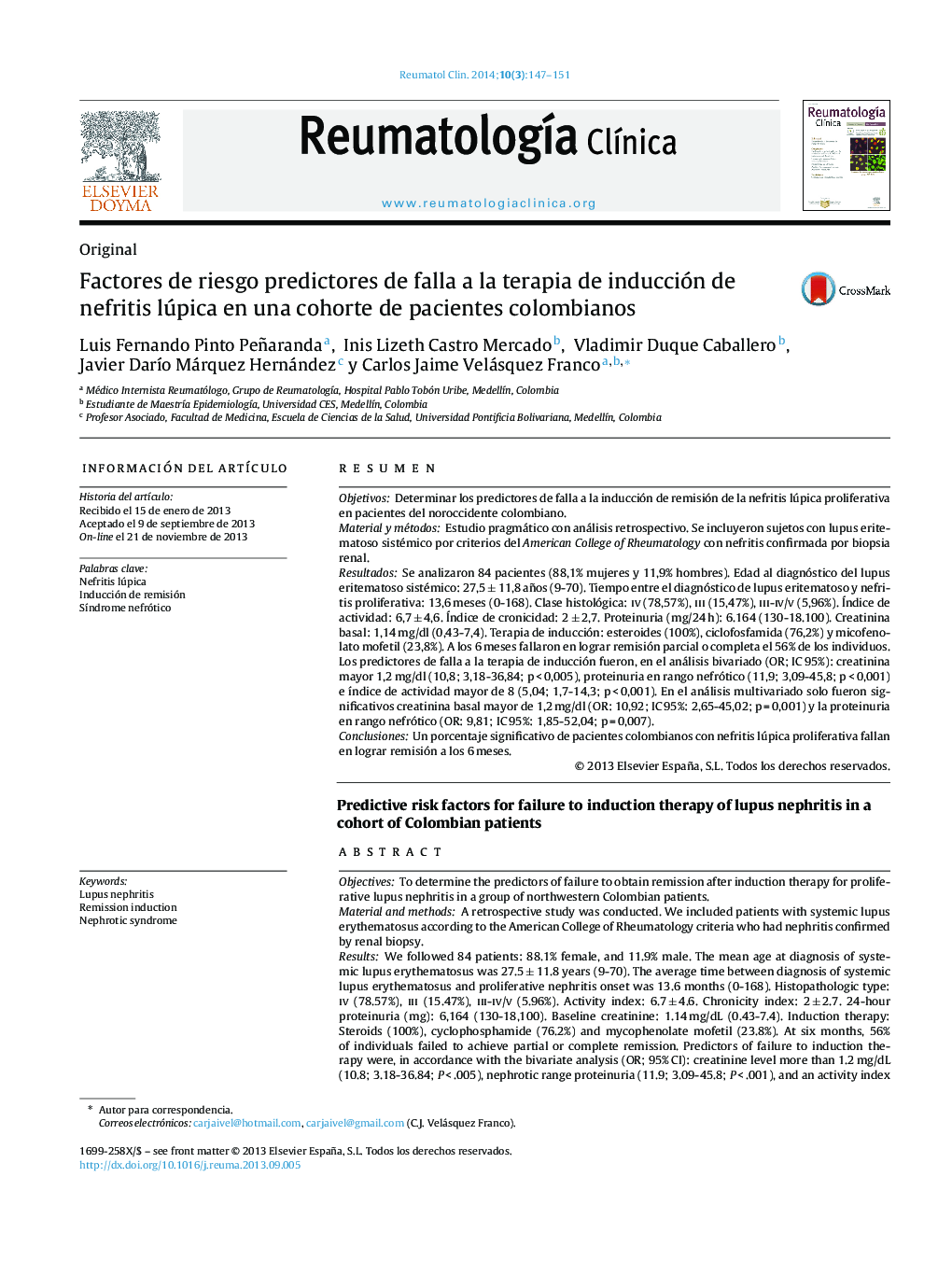| کد مقاله | کد نشریه | سال انتشار | مقاله انگلیسی | نسخه تمام متن |
|---|---|---|---|---|
| 3382960 | 1220431 | 2014 | 5 صفحه PDF | دانلود رایگان |
ResumenObjetivosDeterminar los predictores de falla a la inducción de remisión de la nefritis lúpica proliferativa en pacientes del noroccidente colombiano.Material y métodosEstudio pragmático con análisis retrospectivo. Se incluyeron sujetos con lupus eritematoso sistémico por criterios del American College of Rheumatology con nefritis confirmada por biopsia renal.ResultadosSe analizaron 84 pacientes (88,1% mujeres y 11,9% hombres). Edad al diagnóstico del lupus eritematoso sistémico: 27,5 ± 11,8 años (9-70). Tiempo entre el diagnóstico de lupus eritematoso y nefritis proliferativa: 13,6 meses (0-168). Clase histológica: iv (78,57%), iii (15,47%), iii-iv/v (5,96%). Índice de actividad: 6,7 ± 4,6. Índice de cronicidad: 2 ± 2,7. Proteinuria (mg/24 h): 6.164 (130-18.100). Creatinina basal: 1,14 mg/dl (0,43-7,4). Terapia de inducción: esteroides (100%), ciclofosfamida (76,2%) y micofenolato mofetil (23,8%). A los 6 meses fallaron en lograr remisión parcial o completa el 56% de los individuos. Los predictores de falla a la terapia de inducción fueron, en el análisis bivariado (OR; IC 95%): creatinina mayor 1,2 mg/dl (10,8; 3,18-36,84; p < 0,005), proteinuria en rango nefrótico (11,9; 3,09-45,8; p < 0,001) e índice de actividad mayor de 8 (5,04; 1,7-14,3; p < 0,001). En el análisis multivariado solo fueron significativos creatinina basal mayor de 1,2 mg/dl (OR: 10,92; IC 95%: 2,65-45,02; p = 0,001) y la proteinuria en rango nefrótico (OR: 9,81; IC 95%: 1,85-52,04; p = 0,007).ConclusionesUn porcentaje significativo de pacientes colombianos con nefritis lúpica proliferativa fallan en lograr remisión a los 6 meses.
ObjectivesTo determine the predictors of failure to obtain remission after induction therapy for proliferative lupus nephritis in a group of northwestern Colombian patients.Material and methodsA retrospective study was conducted. We included patients with systemic lupus erythematosus according to the American College of Rheumatology criteria who had nephritis confirmed by renal biopsy.ResultsWe followed 84 patients: 88.1% female, and 11.9% male. The mean age at diagnosis of systemic lupus erythematosus was 27.5 ± 11.8 years (9-70). The average time between diagnosis of systemic lupus erythematosus and proliferative nephritis onset was 13.6 months (0-168). Histopathologic type: iv (78.57%), iii (15.47%), iii-iv/v (5.96%). Activity index: 6.7 ± 4.6. Chronicity index: 2 ± 2.7. 24-hour proteinuria (mg): 6,164 (130-18,100). Baseline creatinine: 1.14 mg/dL (0.43-7.4). Induction therapy: Steroids (100%), cyclophosphamide (76.2%) and mycophenolate mofetil (23.8%). At six months, 56% of individuals failed to achieve partial or complete remission. Predictors of failure to induction therapy were, in accordance with the bivariate analysis (OR; 95% CI): creatinine level more than 1.2 mg/dL (10.8; 3.18-36.84; P < .005), nephrotic range proteinuria (11.9; 3.09-45.8; P < .001), and an activity index above 8 (5.04; 1.7-14.3; P < .001). In the multivariate analysis, only baseline creatinine higher than 1.2 mg/dL (10.92; 2.65-45.02; P = .001), and nephrotic range proteinuria (9.81; 1.85-52.04; P = .007) were significant.ConclusionsA significant percentage of Colombian patients fail to achieve remission of proliferative lupus nephritis after six months of treatment.
Journal: Reumatología Clínica - Volume 10, Issue 3, May–June 2014, Pages 147–151
